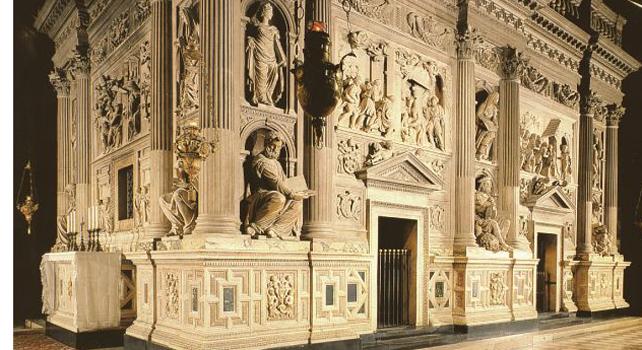Do you know the holy house of Loreto and its history?

The Holy House of Loreto is the first Shrine of international reach dedicated to the Virgin and true Marian heart of Christianity "(John Paul II). The Sanctuary of Loreto in fact preserves, according to an ancient tradition, today proven by historical and archaeological research, the Nazareth house of the Madonna. Maria's earthly home in Nazareth consisted of two parts: a cave carved out of the rock, still venerated in the basilica of the Annunciation in Nazareth, and a masonry chamber in front, consisting of three stone walls placed to close the cave ( see fig. 2).
According to tradition, in 1291, when the crusaders were definitively expelled from Palestine, the masonry walls of the house of the Madonna were transported "by angelic ministry", first to Illyria (in Tersatto, in today's Croatia) and then in the Loreto territory (December 10, 1294). Today, on the basis of new documentary indications, the results of the archaeological excavations in Nazareth and the subsoil of the Holy House (1962-65) and philological and iconographic studies, the hypothesis according to which the stones of the Holy House were transported to Loreto by ship, on the initiative of the noble Angeli family, who reigned over Epirus. In fact, a recently discovered document of September 1294 certifies that Niceforo Angeli, despot of Epirus, in giving his daughter Ithamar in marriage to Filippo of Taranto, fourth child of Charles II of Anjou, king of Naples, transmitted to him a series of dotal goods, among which they appear with marked evidence: "the holy stones taken away from the House of Our Lady the Virgin Mother of God".
Walled among the stones of the Holy House, five crosses of red fabric of crusaders or, more likely, of knights of a military order who in the Middle Ages defended the holy places and relics were found. There were also found some remains of an ostrich egg, which immediately recalls Palestine and a symbolism referring to the mystery of the Incarnation.
The Santa Casa also, for its structure and for the stone material not available in the area, is an artifact unrelated to the culture and building uses of the Marche. On the other hand, the technical comparisons of the Holy House with the Grotto of Nazareth highlighted the coexistence and contiguity of the two parts (see fig. 2).
To confirm the tradition, a recent study on the way in which the stones are worked, that is according to the use of the Nabataeans, widespread in Galilee at the time of Jesus (of fig. 1) is of great importance. Of great interest are also numerous graffiti engraved on the stones of the Holy House, judged by experts of clear Judeo-Christian origin and very similar to those found in Nazareth (see fig. 3).
The Holy House, in its original nucleus, consists of only three walls because the eastern part, where the altar stands, was open towards the Grotto (see fig. 2). The three original walls - without their own foundations and resting on an ancient road - rise from the ground for just three meters. The material above, consisting of local bricks, was added later, including the vault (1536), to make the environment more suitable for worship. The marble cladding, which wraps around the walls of the Holy House, was commissioned by Julius II and was made to a design by Bramante (1507 c). by renowned artists of the Italian Renaissance. The statue of the Virgin and Child, in cedar wood from Lebanon, replaces that of the century. XIV, destroyed by a fire in 1921. Great artists have followed one another over the centuries to embellish the Sanctuary, whose fame spread rapidly all over the world becoming a privileged destination for millions of pilgrims. The famous relic of the Holy House of Mary is an occasion and invitation for the pilgrim to meditate on the high theological and spiritual messages linked to the mystery of the Incarnation and the announcement of Salvation.
The three walls of the Holy House of Loreto
The S. Casa, in its original nucleus, consists of only three walls, because the part where the altar stands overlooked the mouth of the Grotto in Nazareth and therefore did not exist as a wall. Of the three original walls, the lower sections, almost three meters high, consist mainly of rows of stones, mostly sandstone, traceable in Nazareth, and the upper sections added later and therefore spurious, are in local bricks, the only ones building materials used in the area.
A graffiti on the wall of the Holy House
Some stones are externally finished with a technique that recalls that of the Nabataeans, widespread in Palestine and also in Galilee up to the time of Jesus. Sixty graffiti have been identified, many of which judged by experts referable to the Judeo-Christian ones of the remote era. existing in the Holy Land, including Nazareth. The upper sections of the walls, of less historical and devotional value, in the XNUMXth century were covered with fresco paintings, while the underlying stone sections were left exposed, exposed to the veneration of the faithful.
The marble coating is the masterpiece of Lauretan art. It guards the humble House of Nazareth as the casket welcomes the pearl. Wanted by Giulio II and conceived by the great architect Donato Bramante, who in 1509 prepared the design, it was carried out under the direction of Andrea Sansovino (1513-27), Ranieri Nerucci and Antonio da Sangallo the Younger. Later the statues of the Sibyls and the Prophets were placed in the niches.
Marmoreo cladding of the S.Casa
The cladding consists of a base with geometric ornaments, from which an order of two-section striated columns departs, with Corinthian capitals supporting a protruding cornice. The balustrade was added by Antonio da Sangallo (1533-34) with the aim of hiding the clumsy barrel vault of the S. Casa and of circumscribing the admirable marble enclosure with elegant framing.